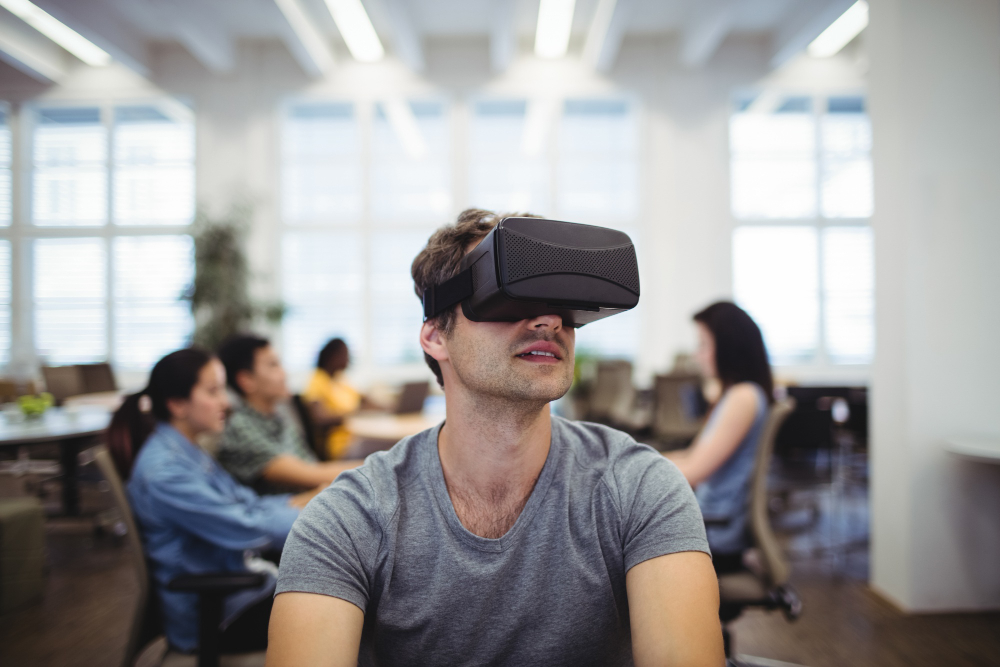
Enhancing Skills – VR Technology Innovations in Defense and Aerospace
VR technology has transformed training and simulation in various sectors, providing immersive experiences that boost learning, enhance safety, and increase efficiency. In sectors such as defense, aerospace, and industrial manufacturing, VR is reshaping how personnel are trained, scenarios are simulated, and complex tasks are performed. This article explores the profound impact of VR in these sectors, highlighting its applications and benefits, as well as the role of leading VR development companies in advancing these technologies.
Virtual Reality (VR) has evolved beyond entertainment, becoming a pivotal tool in training and simulation across a wide range of industries. In defense, aerospace, and industrial manufacturing, VR Technology simulations are revolutionizing how personnel are trained and tasks are performed. These immersive experiences not only replicate real-world scenarios but also provide a safe environment for learning and refining skills. Leading VR development companies play a pivotal role in pushing the boundaries of these technologies, offering tailored solutions that meet the rigorous demands of these specialized industries.
Table of Contents
Applications in Defense:
- Combat Training: VR Technology simulations enable soldiers to train in realistic battlefield scenarios without physical risk, enhancing tactical decision-making and teamwork. Virtual environments can replicate urban warfare, jungle combat, or desert operations, allowing troops to practice maneuvers, communication protocols, and response strategies.
- Vehicle Operation: Military personnel use VR to simulate driving and operating various vehicles, from armored tanks to fighter jets. These simulations provide hands-on experience in complex vehicle controls, navigation systems, and emergency procedures, ensuring readiness and proficiency in diverse operational environments.
- Medical Training: VR plays a crucial role in medical training for military personnel, offering simulations of field hospitals, trauma care scenarios, and surgical procedures. Medics and healthcare providers practice diagnosing injuries, conducting surgeries, and managing emergencies in immersive virtual settings that mimic real-world challenges.
Applications in Aerospace:
- Pilot Training: VR Technology has transformed pilot training by offering realistic flight simulations. Pilots can practice maneuvers, emergency procedures, and cockpit operations in virtual environments that replicate different aircraft models and weather conditions. VR training enhances pilot readiness and proficiency while reducing costs associated with fuel and aircraft maintenance for traditional training flights.
- Maintenance Training: Aerospace engineers and technicians use VR simulations to learn and practice maintenance procedures on aircraft and spacecraft. VR environments provide interactive modules for troubleshooting, repair techniques, and safety protocols, ensuring that maintenance personnel are well-prepared to handle complex equipment and ensure operational reliability.
- Space Exploration: VR Technology simulations are integral to training astronauts for space missions. Astronauts experience zero-gravity environments, spacecraft operations, and extravehicular activities (EVAs) in realistic simulations. VR training prepares astronauts for the challenges of space travel, including navigation, life support systems, and mission-specific tasks.
Applications in Industrial Sectors:
- Manufacturing Processes: VR training is used extensively in industrial sectors to educate workers on assembly line processes, equipment operation, and safety procedures. VR Technology simulations allow employees to practice tasks in a virtual factory environment, reducing errors, improving efficiency, and minimizing production downtime.
- Safety Training: VR Technology is instrumental in industrial safety training, providing immersive simulations of hazardous scenarios such as chemical spills, fires, or equipment malfunctions. Employees learn emergency response protocols and risk mitigation strategies in a safe, virtual setting, preparing them to handle real-world incidents effectively while minimizing workplace accidents and injuries.
- Remote Collaboration: VR technology facilitates remote collaboration among global teams in industrial sectors. Engineers and designers can collaborate on 3D models of products, factories, or infrastructure projects in virtual environments. VR enables real-time interaction, visualization of complex designs, and collaborative problem-solving, enhancing productivity and accelerating project timelines.
Benefits of VR Technology Training and Simulation:
- Realism and Immersion: VR provides a high degree of realism and immersion, replicating real-world environments and scenarios with spatial audio, realistic visuals, and interactive elements. Trainees feel fully immersed in virtual simulations, enhancing engagement and learning retention.
- Cost-Effectiveness: Virtual training reduces costs associated with traditional methods, such as equipment setup, travel expenses, and material consumption. VR simulations eliminate the need for physical infrastructure and reduce operational downtime, making training programs more cost-efficient and scalable.
- Safety and Risk Mitigation: VR simulations allow for safe training in hazardous or high-risk environments, minimizing physical risks to trainees and equipment. Employees can practice dangerous tasks or emergency procedures without jeopardizing their safety, ensuring preparedness for real-world challenges.
- Skill Enhancement: VR enhances learning retention and skill development through interactive and repetitive practice in a controlled setting. Trainees can repeat simulations, receive instant feedback, and track performance metrics, allowing for continuous improvement and mastery of complex tasks.
Role of Leading VR Development Companies:
- Customized Solutions: Leading VR development companies specialize in creating customized solutions that address specific training needs and operational challenges within defense, aerospace, and industrial sectors. They collaborate closely with clients to understand unique requirements and design VR simulations that meet industry standards and regulatory compliance.
- Innovation and Research: Top VR developers invest in research and development (R&D) to advance VR technologies and applications. They integrate innovations such as artificial intelligence (AI), machine learning, haptic feedback systems, and real-time data analytics to enhance simulation realism and user experience.
- Collaboration with Industry Leaders: VR development companies partner with industry leaders, including government agencies, aerospace manufacturers, defense contractors, and industrial conglomerates. These partnerships ensure that VR solutions align with industry trends, technological advancements, and operational expectations, fostering innovation and continuous improvement.
Conclusion:
In conclusion, Virtual Reality (VR) has emerged as a game-changer in training and simulation across defense, aerospace, and industrial sectors. Its ability to provide immersive, realistic experiences enhances training effectiveness, improves operational efficiency, and enhances safety. Leading VR Technology development companies are at the forefront of driving these innovations, delivering customized solutions that meet the unique challenges and demands of each sector. As VR technology continues to evolve, its impact on training and simulation will only grow, shaping the future of workforce readiness and operational excellence across industries.
By leveraging VR technology, organizations can transform training programs, empower personnel with critical skills, and optimize operational performance. The adoption of VR in defense, aerospace, and industrial sectors not only enhances workforce readiness but also positions companies at the forefront of innovation in a competitive global market. As VR development continues to advance, the potential for creating impactful and scalable training solutions will expand, driving continuous improvement and sustainable growth for organizations embracing these transformative technologies.
June 20, 2024
















